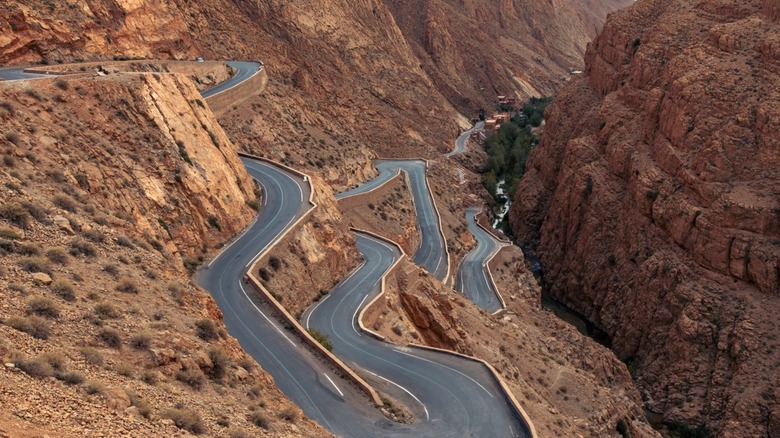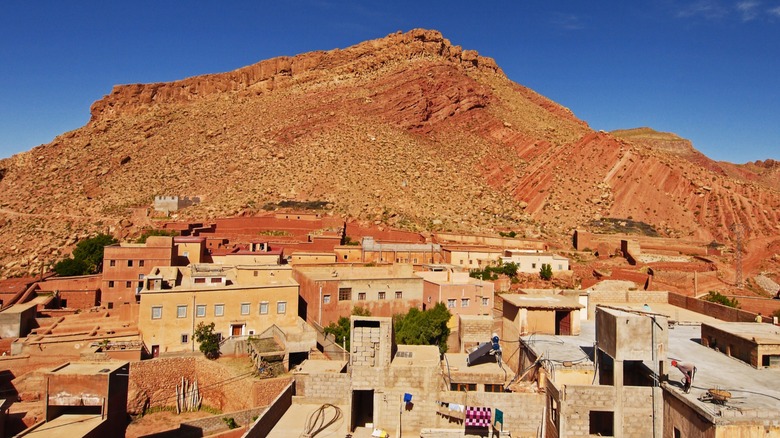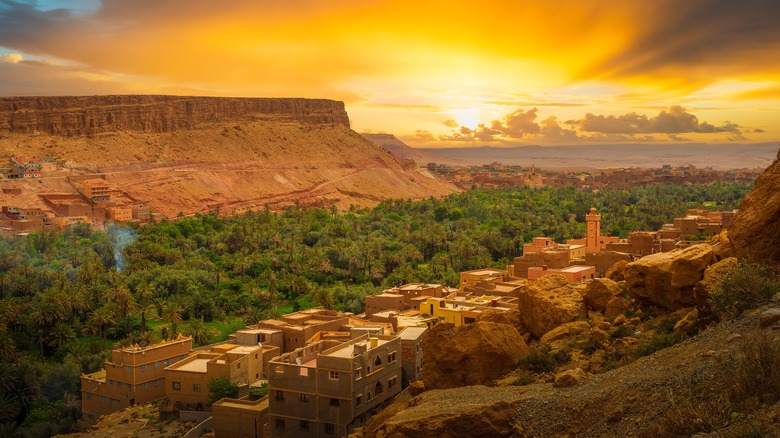'Morocco's Grand Canyon' Is A Phenomenal Destination Where Tourists Love To Trek, Drive, And Explore
Morocco attracts visitors from around the world to its coastal cities, dramatic landscapes, and the Sahara Desert towns with picturesque sand dunes and lush oases. The country's southern regions are no exception, with their equally impressive sights and stunning natural beauty. One particularly postcard-worthy spot is the Dadès Gorge, a spectacular canyon stretching out over 15 miles and snaking through an imposing mountain range. It actually consists of several separate wadi gorges carved by the Dadès River, which originates in the High Atlas Mountains and ends when it joins the Draa River at the edge of the Sahara.
Over millions of years, tectonic forces pushed the Atlas Mountains above the sea in which they were submerged. This created the river that cut through the sedimentary rock, shaping the Dadès Gorge into what it is today. The name "Dadès" comes from the word "dada," which means "valley" in Arabic — and nowhere can you find a more dramatically beautiful, fertile valley than here. There is also a local legend about this valley: The wind has a son living in the town of Boumalne Dadès, so every winter, he rushes down the valley to visit him — hence the strong gusts here that whip through the gorge and unsettle the dust.
A trip to this scenic area is an absolute must for visitors who want to learn about Morocco's rich history, experience traditional Amazigh (Berber) nomadic culture, and enjoy awe-inspiring views of the Dadès Gorge, referred to by many as "Morocco's Grand Canyon." While a visit at any time of year is fine, it's best to come in late spring, summer, and early fall (May to September), when the temperatures are moderate, the ground is dry, and the winds are less intense.
Where to stay and what to do in the Dadès Gorge
The best place to base yourself if you'd like to explore the Dadès Gorge is in Boumalne Dadès. It's about five hours (200 miles) east of Marrakesh, one of the best destinations in the world for a stress-free wellness vacation, and around eight hours (340 miles) southeast of Casablanca, Morocco's biggest city full of art and culture. You'll find a wide variety of accommodations in Boumalne Dadès, from classic kasbahs converted into guesthouses to luxurious four-star hotels.
If you're driving or are part of a guided tour, you'll take the main thoroughfare snaking through the gorge, the R704 or Dadès Gorge Road, which starts in Boumalne Dadès and continues north to Agoudal. It's less than 80 miles long (although not all of it is well-paved). R704 is also referred to as the Road of a Thousand Kasbahs due to the prevalence of these ancient fortifications dotting the landscape. Along the way, pop into an Amazigh village for a chat and a cup of mint tea with locals. Head to Hotel Restaurant Timzzillite and sit on the balcony for an excellent view of the gorge and surrounding sun-kissed rock faces.
For adventurous travelers, mountain biking expeditions, 4x4 vehicle tours, and hiking trips are more intrepid options. They will allow you to connect with nature and explore Dadès Gorge hands-on — scramble over boulders, wander past groves of almond, fig, and pomegranate trees, and admire the earthen adobe homes. Make sure to stop at one of the many viewpoints for photos, to see unique geological formations, and to admire the vista of verdant foliage set against rust-red rock faces under the bright blue sky. These types of trips can be easily booked through your hotel.
Planning your visit to the Dadès Gorge
As of 2025, passport holders from 70 countries, including the U.S., do not need a visa to enter Morocco and can stay for a short-term visit (for tourism purposes only). Americans and citizens of most other nations will be granted a 90-day stay. To get to Morocco from the U.S., travelers usually fly into either Casablanca or Marrakesh. There are international airports in other Moroccan cities, including Fes, Agadir, and Ouarzazate, which is the closest one to Boumalne Dadès at 75 miles away. However, flights to these smaller airports typically include at least two stopovers and go through Casablanca.
Meanwhile, at the time of writing, there are non-stop flights from New York's JFK airport and from D.C.'s Washington Dulles airport to Casablanca and a non-stop flight from New Jersey's Newark Liberty airport to Marrakesh. Upon arrival, you can take the bus or train from either city, and there's also a direct CTM bus to Boumalne Dadès from Ouarzazate. However, for the ultimate comfort and convenience, most previous visitors recommend renting a car.
There are several things to be aware of if you choose to drive yourself around Morocco. Driving at night is not a good idea, particularly if you are unfamiliar with the terrain. Pay attention to and follow speed limits, as police are ready and willing to fine rule-breakers. The Dadès Gorge Road, in particular, is dangerous at high speeds, as it's narrow in some parts, has several hairpin turns, and there are no barriers to protect you from the vertiginous drop below. If you are visiting during the fall or winter, be aware that flash floods can make the road especially slippery, and heavy snowfall can make some sections impassable.


